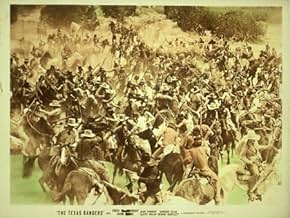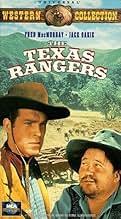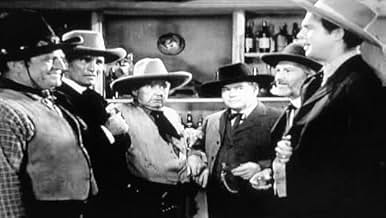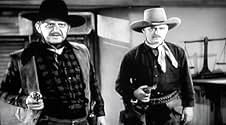IMDb-BEWERTUNG
6,5/10
881
IHRE BEWERTUNG
Füge eine Handlung in deiner Sprache hinzuTwo down-on-their-luck former outlaws volunteer to be Texas Rangers and find themselves assigned to bring in an old friend, now a notorious outlaw.Two down-on-their-luck former outlaws volunteer to be Texas Rangers and find themselves assigned to bring in an old friend, now a notorious outlaw.Two down-on-their-luck former outlaws volunteer to be Texas Rangers and find themselves assigned to bring in an old friend, now a notorious outlaw.
- Für 1 Oscar nominiert
- 1 Nominierung insgesamt
Benny Bartlett
- David
- (as Bennie Bartlett)
Fred Kohler
- Jess Higgins
- (as Fred Kohler Sr.)
George 'Gabby' Hayes
- Judge Snow
- (as George Hayes)
Stanley Andrews
- First Higgins Henchman
- (Nicht genannt)
Irving Bacon
- David's Father
- (Nicht genannt)
Kathryn Bates
- School Teacher
- (Nicht genannt)
John Beck
- Stage Passenger
- (Nicht genannt)
Hank Bell
- Hank Wallace, Texas Ranger
- (Nicht genannt)
Virginia Brissac
- David's Mother
- (Nicht genannt)
Empfohlene Bewertungen
On a whim, bandits Fred MacMurray and Jack Oakie enlist in the Texas Rangers. The two partner up with old pal Lloyd Nolan for some crooked schemes, but soon hear the call of duty, putting them at odds with their criminal lifestyle.
Like his most famous film, The Champ, director King Vidor imbues this with depression-era sensibilities and sentimentality, having lovable bums MacMurray and Oakie find self-respect, romance, and a sense of selflessness, all with a young orphan in tow.
Photography, direction, and action sequences are all first rate. The performances were a little dated, but adequate. Unlike others, I didn't find Oakie's good-old-boy character annoying or unrealistic.
Cameo appearances by George "Gabby" Hayes and Charles Middleton (Ming the Merciless) were a lot of fun too.
Like his most famous film, The Champ, director King Vidor imbues this with depression-era sensibilities and sentimentality, having lovable bums MacMurray and Oakie find self-respect, romance, and a sense of selflessness, all with a young orphan in tow.
Photography, direction, and action sequences are all first rate. The performances were a little dated, but adequate. Unlike others, I didn't find Oakie's good-old-boy character annoying or unrealistic.
Cameo appearances by George "Gabby" Hayes and Charles Middleton (Ming the Merciless) were a lot of fun too.
The Texas Rangers is directed by King Vidor who also co-writes with Elizabeth Hill, Louis Stevens and Walter Prescott Webb. It stars Fred MacMurray, Jack Oakie, Jean Parker and Lloyd Nolan. Music is by Gerard Carbonara and cinematography by Edward Cronjager. Plot has MacMurray and Oakie as two outlaws who decide to become Texas Rangers, something which invariably brings them into conflict with another outlaw pal.
It showcases the good and bad of 1930s Westerns. The action is strong and vibrant, the landscapes appealing and the story as a premise is always interesting. But those good points are countered with weak scripting, goofs, logic holes and a mixed bag of acting performances. But all told, Vidor's movie comes through its problems to stay firmly on the good side of good for the Western fan.
It's good guys versus bad guys on the home front, with the Indians lining up in numbers to be the common foe. It's here for the latter, where Vidor excels, constructing the action scenes with great skill as a ream of extras in Indian attire attack in their droves, arrows and bullets fly with murderous worth, bodies hurl and fall about, it's exciting stuff. The highlight coming as the Indians start flinging boulders off of a cliff face down onto the Rangers down below; the sound work here especially great, as is the stunt work in this whole segment of the film.
MacMurray and Oakie make a likable pair, but both seem a touch out of place in this portion of the Wild West. But Nolan cuts a nice snarly figure as chief villain Sam "Polka Dot" McGee, and he gets to deliver the film's best (nastiest) moment. Parker is pretty but pretty much a token, while secondary support slots are capably filled by the likes of Edward Ellis, Benny Bartlett and Frank Shannon. Cronjager's black and white photography is on the money, neatly utilising the New Mexico locations as wide open vistas that impose on the characters. While Carbonara scores it with standard Cowboys and Indian flavours for the attacks, and bombastic machismo for the Texas Rangers patrols.
Full of formula and mixed signals as to what it wants to be, The Texas Rangers is none the less an enjoyable picture and one of the better Oaters from the 30s. 7/10
Footnote: A sequel followed in 1940 called The Texas Rangers Ride Again. In 1949 The Texas Rangers was remade as Streets of Laredo, with William Holden starring.
It showcases the good and bad of 1930s Westerns. The action is strong and vibrant, the landscapes appealing and the story as a premise is always interesting. But those good points are countered with weak scripting, goofs, logic holes and a mixed bag of acting performances. But all told, Vidor's movie comes through its problems to stay firmly on the good side of good for the Western fan.
It's good guys versus bad guys on the home front, with the Indians lining up in numbers to be the common foe. It's here for the latter, where Vidor excels, constructing the action scenes with great skill as a ream of extras in Indian attire attack in their droves, arrows and bullets fly with murderous worth, bodies hurl and fall about, it's exciting stuff. The highlight coming as the Indians start flinging boulders off of a cliff face down onto the Rangers down below; the sound work here especially great, as is the stunt work in this whole segment of the film.
MacMurray and Oakie make a likable pair, but both seem a touch out of place in this portion of the Wild West. But Nolan cuts a nice snarly figure as chief villain Sam "Polka Dot" McGee, and he gets to deliver the film's best (nastiest) moment. Parker is pretty but pretty much a token, while secondary support slots are capably filled by the likes of Edward Ellis, Benny Bartlett and Frank Shannon. Cronjager's black and white photography is on the money, neatly utilising the New Mexico locations as wide open vistas that impose on the characters. While Carbonara scores it with standard Cowboys and Indian flavours for the attacks, and bombastic machismo for the Texas Rangers patrols.
Full of formula and mixed signals as to what it wants to be, The Texas Rangers is none the less an enjoyable picture and one of the better Oaters from the 30s. 7/10
Footnote: A sequel followed in 1940 called The Texas Rangers Ride Again. In 1949 The Texas Rangers was remade as Streets of Laredo, with William Holden starring.
"The Texas Rangers" tells the story of three pals (Fred MacMurray, Jack Oakie, Lloyd Nolan) who are living the lives of outlaws until they become separated when cornered by a posse. MacMurray and Oakie wind up joining the Texas Rangers while Nolan becomes the notorious "Polka Dot Bandit". Eventually you know that the two sides will have the inevitable showdown. Great action scenes involving an Indian attack highlight the film.
A very young clean-shaven MacMurray is good in the lead and Jack Oakie is..well Jack Oakie as MacMurray's trusty sidekick. Nolan is fittingly evil as the grinning villain of the piece. Heroine Jean Parker plays MacMurray's love interest who convinces him of the error of his ways.
In the courtroom scene, watch for "B" western favorites George "Gabby" Hayes as a judge, Fred Kohlor as the town boss and Charles (Ming the Merciless) Middleton as his lawyer.
If the story seems familiar, it was remade as "The Streets of Laredo" in 1949 with William Holden, William Bendix and Macdonald Carey in the MacMurray, Oakie and Nolan roles respectively.
A very young clean-shaven MacMurray is good in the lead and Jack Oakie is..well Jack Oakie as MacMurray's trusty sidekick. Nolan is fittingly evil as the grinning villain of the piece. Heroine Jean Parker plays MacMurray's love interest who convinces him of the error of his ways.
In the courtroom scene, watch for "B" western favorites George "Gabby" Hayes as a judge, Fred Kohlor as the town boss and Charles (Ming the Merciless) Middleton as his lawyer.
If the story seems familiar, it was remade as "The Streets of Laredo" in 1949 with William Holden, William Bendix and Macdonald Carey in the MacMurray, Oakie and Nolan roles respectively.
This Western from back in 1936. It doesn't have the fancy special effects, nor color, nor big budget, etc. But it will stand up to just about any Western made today. In glorious black and white, it is one to see when you get the opportunity. Fred MacMurray is the star and does one of his best jobs of acting (seemed more relaxed), Jack Oakie (a great character actor with just the right touch of humor), Lloyd Nolan (who played the bad guy so well) and Jean Parker (the pretty girl who tames MacMurray). The story starts out with three friends who rob stage coaches until a posse catches up to them and they have to split up. MacMurray and Oakie become Texas Rangers with the idea of getting inside info for more hold ups. But experience with the Rangers and a smart girl turn the boys toward the side of the law. Problem is that LLoyd Nolan is still on the opposite side of the law and causing problems. Not to give anything away, but you can guess the ultimate showdown arrives. In between is plenty of action and exciting Indian attacks. Don't miss this one if you like Cowboys and Indians.
The Western genre was at a low ebb in the 1930s. It did not die out completely as has sometimes been claimed, but for the most part it was relegated to B-movie status (in fact B-Westerns were what John Wayne spent most of the 30s doing). It's also untrue that the genre was suddenly revived in 1939 by the arrival of Stagecoach. A-budget Westerns had been appearing for a few years before then, but they were odd affairs for the most part, born of a generation who had lost touch with the Old West.
The Texas Rangers was perhaps the first of these bigger Westerns, and in many ways it plays like a recap of genre conventions, particularly the more farcical aspects. We have bandits who are good guys deep down, and Indians who might as well be hordes of zombies. Some of the more fun clichés, like an alcoholic judge, are briefly touched upon, but only briefly. The screenplay is on the whole a rather amateurish effort, riding roughshod over logic whenever a gap in the plot needs sewing up. I mean, are we really supposed to believe Jack Oakie is off in the hills counting out his loot by night, and yet is still consistently able to get his job as Stagecoach driver back each morning? Silly, even by the standards of the genre.
And yet producer-director King Vidor was the kind of man to take such projects seriously. And he at least has a feel for the form. Too many of these 30s Westerns fail to make proper use of the open plains, which after all is what it's all supposed to be about. Not Vidor though – for him the seemingly endless vistas are an almost continual backdrop. Vidor's outdoor shots give you a real feeling of the emptiness, which is essential. You can't have a character singing "Bury Me Not on the Lone Prairie" unless the prairie looks appropriately lonesome. Vidor's direction of dialogue scenes is immaculate as always, generally holding the actors in long takes with occasional barely-perceptible camera shift, giving a real feeling of smoothness. His handling of action is the opposite, full of wild cuts and crazed angles to give a real feeling of frenzy. One of the most effective manoeuvres he pulls in The Texas Rangers is just before the heroes come face-to-face with the massive band of Indians. We begin with a tracking shot of them riding alongside a rock face, then the camera gradually turns, opening out the space, and eerily revealing the army of natives.
Unfortunately not everyone is so suited to the genre. I don't buy MacFred as a Westerner, let alone a bandit. He just doesn't have the demeanour of a two-baths-a-year man. Leading lady Jean Parker is simply bland here, as is her character. Fortunately we do get to see a lot of Jack Oakie, who still doesn't quite look the part but is entertaining nevertheless. Oakie may be a comic but he can really act, as you will see in the one or two scenes where he has to play it straight. Lloyd Nolan is great too – his face says things that aren't in the script. And any picture that has Edward Ellis in is bound to be a treat. He is also the only player with a real bit of Western grit about him.
The Texas Rangers may be the Western genre's reunion with big budgets and big stars, but it is really little more than a souped-up B-Western. It is directed with class, but the overall feel is one of shoddiness, mainly because the studios at the time weren't used to the form. They didn't have the stockpile of authentic performers or the ready-made frontier-towns at their disposal. We get the wide-open plains alright, but it takes more than chaps and Stetsons to conjure up the spirit of the Old West.
The Texas Rangers was perhaps the first of these bigger Westerns, and in many ways it plays like a recap of genre conventions, particularly the more farcical aspects. We have bandits who are good guys deep down, and Indians who might as well be hordes of zombies. Some of the more fun clichés, like an alcoholic judge, are briefly touched upon, but only briefly. The screenplay is on the whole a rather amateurish effort, riding roughshod over logic whenever a gap in the plot needs sewing up. I mean, are we really supposed to believe Jack Oakie is off in the hills counting out his loot by night, and yet is still consistently able to get his job as Stagecoach driver back each morning? Silly, even by the standards of the genre.
And yet producer-director King Vidor was the kind of man to take such projects seriously. And he at least has a feel for the form. Too many of these 30s Westerns fail to make proper use of the open plains, which after all is what it's all supposed to be about. Not Vidor though – for him the seemingly endless vistas are an almost continual backdrop. Vidor's outdoor shots give you a real feeling of the emptiness, which is essential. You can't have a character singing "Bury Me Not on the Lone Prairie" unless the prairie looks appropriately lonesome. Vidor's direction of dialogue scenes is immaculate as always, generally holding the actors in long takes with occasional barely-perceptible camera shift, giving a real feeling of smoothness. His handling of action is the opposite, full of wild cuts and crazed angles to give a real feeling of frenzy. One of the most effective manoeuvres he pulls in The Texas Rangers is just before the heroes come face-to-face with the massive band of Indians. We begin with a tracking shot of them riding alongside a rock face, then the camera gradually turns, opening out the space, and eerily revealing the army of natives.
Unfortunately not everyone is so suited to the genre. I don't buy MacFred as a Westerner, let alone a bandit. He just doesn't have the demeanour of a two-baths-a-year man. Leading lady Jean Parker is simply bland here, as is her character. Fortunately we do get to see a lot of Jack Oakie, who still doesn't quite look the part but is entertaining nevertheless. Oakie may be a comic but he can really act, as you will see in the one or two scenes where he has to play it straight. Lloyd Nolan is great too – his face says things that aren't in the script. And any picture that has Edward Ellis in is bound to be a treat. He is also the only player with a real bit of Western grit about him.
The Texas Rangers may be the Western genre's reunion with big budgets and big stars, but it is really little more than a souped-up B-Western. It is directed with class, but the overall feel is one of shoddiness, mainly because the studios at the time weren't used to the form. They didn't have the stockpile of authentic performers or the ready-made frontier-towns at their disposal. We get the wide-open plains alright, but it takes more than chaps and Stetsons to conjure up the spirit of the Old West.
Wusstest du schon
- WissenswertesKing Vidor made this movie to honor the celebrations of the centennial of the state of Texas.
- PatzerHawkins and the other Rangers are surrounded by Indians. He kills the 2 Indians rolling rocks, throwing his empty pistol at one. As he descends the other side, he mounts a bareback horse, riding off shooting a pistol that shouldn't be there as he rides away.
- Zitate
Wahoo Jones: How do you expect to find Sam down in this country? Texas! Phooey! No towns, no ranch houses, no gals, no nuthin'. Hah! We can't see a jack rabbit in two days. Boy, you can't tell me we're still in the United States!
- VerbindungenEdited into Texas Rangers Ride Again (1940)
Top-Auswahl
Melde dich zum Bewerten an und greife auf die Watchlist für personalisierte Empfehlungen zu.
Details
- Laufzeit1 Stunde 38 Minuten
- Farbe
- Seitenverhältnis
- 1.37 : 1
Zu dieser Seite beitragen
Bearbeitung vorschlagen oder fehlenden Inhalt hinzufügen

Oberste Lücke
By what name was Grenzpolizei Texas (1936) officially released in India in English?
Antwort

































